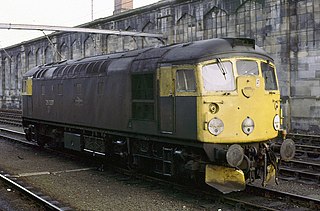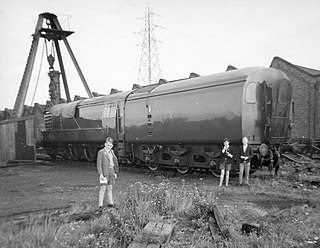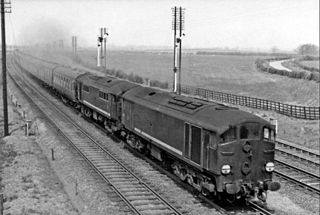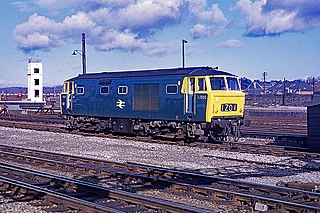
D0280 Falcon was a single prototype diesel-electric locomotive, built for British Railways in 1961. It was one of a series of three prototypes: Falcon, DP2 and Lion, eventually leading to the Class 47 and Class 50. A requirement was expressed by the BTC at a meeting on 15 January 1960 for new Type 4 designs of Co-Co arrangement, which would be lighter than the earlier 1Co-Co1 locomotives such as the Peak classes, produced under the Pilot Scheme.

The British Rail Class 55, also known as a Deltic, or English Electric Type 5, is a class of diesel locomotive built in 1961 and 1962 by English Electric for British Railways. Twenty-two locomotives were built, designed for the high-speed express passenger services on the East Coast Main Line (ECML) between Edinburgh and London King's Cross. They gained the name "Deltic" from the prototype locomotive, DP1 Deltic, which in turn was named after its Napier Deltic power units. At the time of their introduction into service in 1961, the Class 55s were the most powerful single-unit diesel locomotives in the world, with a power output of 3,300 hp (2,500 kW). They had an official maximum speed of 100 miles per hour (160 km/h), and introduced the first regular 100 mph diesel passenger service to Britain, they were however capable of higher speeds than this, and often exceeded their official maximum in service, especially in their later years, with speeds of up to 117 miles per hour (188 km/h), being recorded on level gradients, and up to 125 miles per hour (201 km/h) whilst descending Stoke Bank.

The British Rail Class 52 is a class of 74 Type 4 diesel-hydraulic locomotives built for the Western Region of British Railways between 1961 and 1964. All were given two-word names, the first word being "Western" and thus the type became known as Westerns. They were also known as Wizzos and Thousands. The final Class 52 locomotives were withdrawn from service in 1977.

The British Rail Class 40 is a type of British railway diesel electric locomotive. A total of 200 were built by English Electric between 1958 and 1962. They were numbered D200-D399. They were, for a time, the pride of British Rail's early diesel fleet. However, despite their initial success, by the time the last examples were entering service they were already being replaced on some top-level duties by more powerful locomotives. As they were slowly relegated from express passenger uses, the type found work on secondary passenger and freight services where they worked for many years. The final locomotives ended regular service in 1985. The locomotives were commonly known as "Whistlers" because of the distinctive noise made by their turbochargers.

The British Rail Class 47 or Brush Type 4 is a class of diesel-electric locomotive that was developed in the 1960s by Brush Traction. A total of 512 Class 47s were built at Brush's Falcon Works in Loughborough and at British Railways' Crewe Works between 1962 and 1968, which made them the most numerous class of British mainline diesel locomotive.

The British Railways Class 24 diesel locomotives, also known as the Sulzer Type 2, were built from 1958 to 1961. One hundred and fifty-one were built at Derby, Crewe and Darlington, the first twenty of them as part of the British Railways 1955 Modernisation Plan. This class was used as the basis for the development of the Class 25 locomotives.

The British Rail Class 26 diesel locomotives, also known as the BRCW Type 2, were built by the Birmingham Railway Carriage and Wagon Company (BRCW) at Smethwick in 1958–59. Forty seven examples were built, and the last were withdrawn from service in 1994. Like their higher-powered sisters, the BRCW Classes 27 and 33, they had all-steel bodies and cab ends with fibreglass cab roofs. They were numbered D5300-D5346.

Barrow Hill Roundhouse, until 1948 known as Staveley Engine Shed, is a former Midland Railway roundhouse in Barrow Hill, near Staveley and Chesterfield, Derbyshire, now serving as a railway heritage centre.

English Electric DP1, commonly known as Deltic, is a prototype 3,300 hp (2,500 kW) demonstrator locomotive employing two Napier Deltic engines, built by English Electric in 1955.

D0226 and D0227 were two prototype diesel shunting locomotives built in 1956 by English Electric at its Vulcan Foundry in Newton-le-Willows to demonstrate its wares to British Railways. They originally carried numbers D226 and D227, their Vulcan Foundry works numbers, but these were amended in August 1959 to avoid clashing with the numbers of new Class 40 locomotives.

D0260, named Lion, was a prototype Type 4 mainline diesel-electric locomotive built in 1962 by a consortium of Birmingham Railway Carriage and Wagon Company, Sulzer the engine maker and Associated Electrical Industries, at BRCW's Smethwick works near Birmingham.

GT3 was a prototype mainline gas turbine locomotive built in 1961 by English Electric at their Vulcan Foundry in Newton-le-Willows to investigate the use of its gas turbines in rail traction applications. It followed 18000 and 18100 as gas turbines 1 and 2. It was designed by English Electric engineer J. O. P. Hughes in a project that started in the early 1950s. Externally it resembled a steam tender locomotive, but the tender carried kerosene fuel. The designer said the traditional chassis and mechanical transmission avoided complications with relatively untried technologies for bogies and electrical transmission.

The British Rail Class 37 is a diesel-electric locomotive. Also known as the English Electric Type 3, the class was ordered as part of the British Rail modernisation plan. They were numbered in two series, D6600–D6608 and D6700–D6999.

The British Rail Class 50 is a class of diesel locomotives designed to haul express passenger trains at 100 mph (160 km/h). Built by English Electric at the Vulcan Foundry in Newton-le-Willows between 1967 and 1968, the Class 50s were initially on a 10-year lease from English Electric Leasing, and were employed hauling express passenger trains on the, then non-electrified, section of the West Coast Main Line between Crewe and Scotland. Initially numbered D400–D449 and known as English Electric Type 4s, the locomotives were purchased outright by British Rail (BR) at the end of the lease and became Class 50 in the TOPS renumbering of 1973.

The British Rail Class 28 diesel-electric locomotives, known variously as 'Metrovicks', 'Crossleys' or 'Co-Bos', were built under the Pilot Scheme for diesel locomotives as part of the British Railways 1955 Modernisation Plan.

The British Rail Class 41 were two powercars built in 1972 by British Rail Engineering Limited's Crewe Works to operate with the prototype High Speed Train (HST) with Mark 3 carriages.

The British Rail Class 42 Warship diesel-hydraulic locomotives were introduced in 1958. It was apparent at that time that the largest centre of expertise on diesel-hydraulic locomotives was in West Germany. The Western Region of British Railways negotiated a licence with German manufacturers to scale down the German Federal Railway's "V200" design to suit the smaller loading gauge of the British network, and to allow British manufacturers to construct the new locomotives. The resultant design bears a close resemblance, both cosmetically and in the engineering employed, to the original V200 design. Warship locomotives were divided into two batches: those built at BR's Swindon works were numbered in the series D800-D832 and D866-D870, had a maximum tractive effort of 52,400 pounds-force (233,000 N) and eventually became British Rail Class 42. 33 others, D833–D865, were constructed by the North British Locomotive Company and became British Rail Class 43. They were allocated to Bristol Bath Road, Plymouth Laira, Newton Abbot and Old Oak Common.

The British Rail Class 35 is a class of mixed-traffic B-B diesel locomotive with hydraulic transmission. Because of their Mekydro-design hydraulic transmission units, the locomotives became known as the Hymeks. They were numbered D7000-D7100.

The British Rail Class 22 or "Baby Warship" was a class of diesel-hydraulic locomotives designed for the Western Region of British Railways and built by the North British Locomotive Company. They were very similar in appearance to the Class 21 diesel-electrics. The nickname Baby Warship related to the similarity in appearance to the British Rail Class D20/2 or Class 41 Warship Class. The Class 22s were numbered D6300-D6357.

The British Rail Class 23 were a class of ten Bo-Bo diesel-electric locomotives built by the English Electric Company (EE) in 1959. The power unit used was a Napier Deltic T9-29 9-cylinder engine of 1,100 bhp (820 kW) driving an EE generator, which powered the four traction motors. They were numbered from D5900 to D5909.






















